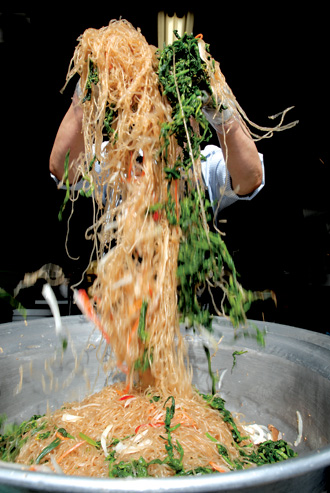By Namju Cho Photographs by Eric Sueyoshi
We’ve all done it — that is, those of us lucky enough to have large Korean markets at our disposal. After fetching fresh greens you can’t find at mainstream markets and grabbing a package of marinated meats, you wander into the banchan section replete with neatly packaged side dishes.
Will you pick up some namul — seasoned spinach, bean sprouts or mushrooms — and whip it up with steamed rice and red pepper sauce for a healthy bowl of bibimbap? Or will you get your spice fix with baby squid pickled in a fiery red sauce? Finally, you settle for piping hot slices of bindaedduk, crispy mung bean pancakes that are fresh off the fry pan.
[ad#336]
Welcome to the Korean version of the soup and salad bar, where the variety is astounding, the translated labels at times perplexing, and the story behind the preparation quintessentially American.
Store-bought banchan, which generally refers to anything on the table that isn’t rice or soup, has become so prevalent that no self-respecting Korean market in a major city will offer less than two dozen varieties, including warm and cold dishes.
Hannam Chain, on Olympic and Vermont in L.A.’s Koreatown, is no exception. On a recent Saturday morning, scents of garlic and sesame oil typical of a Korean kitchen permeate the air in the store’s bustling banchan department. Large batches of kosari, brown stems that will later be seasoned with salt, garlic and sesame oil, are boiling away in a vat of water, and cooked glass noodles sit in a container soon to be transformed into japchae, a kind of warm noodle salad made with meat and vegetables.
Jinho Kim, head of Hannam’s banchan department, moves swiftly around the multiple food stations making sure the ingredients are assembled properly and everything tastes right.
“The key to making good banchan is the seasoning,” she says.
[ad#336]
But don’t ask her for specific measurements. Like many an accomplished Korean cook, Kim says her secret to perfectly seasoned banchan boils down to “son mat,” literally translated as “taste of hand.” In other words, just like her own mother whose shoulder Kim would peer over in the kitchen, Kim uses her instincts.
“I keep to tradition,” adds the petite 58-year-old. “Even though some have asked me to make [this or that] saltier or spicier, I think it’s important to preserve our cultural heritage.”
Yet, in today’s modern supermarket kitchen, Kim is also adjusting to change. Many of her employees are Latinos, and oftentimes, they are the ones to whom she is passing on these Korean culinary traditions.
Take Coronado Ramos, a 37-year-old Salvadoran worker who is responsible for washing and cutting radishes to make kimchi, a spicy fermented dish that accompanies every Korean meal. When he started working under Kim 12 years ago, he knew nothing about Korean food. “Now I’m an expert,” he says.
Although fermented cabbage is not everyone’s idea of a savory side, Ramos is a big fan of kimchi, as well as the mung bean pancakes sizzling away in an adjacent room.
Oliva Mona, from Veracruz, Mexico, has almost perfected the art of making banchan by observing Kim in action for years. “It’s not too difficult, …and the ingredients are familiar to me,” says the bashful 47-year-old Mona, while stirring a big pot of boiling wild aster.
Says Kim: “Oliva makes better Korean food than some Koreans!”
Just before lunch hour on this Saturday, Grace Kim (no relation to Jinho Kim) makes a pit stop at the banchan aisle and picks out some warm steamed tofu and panfried fish fillets. “It’s a great alternative when I don’t have time to make it at home,” says the 51-year-old working mom.
A few minutes later, a couple comes rushing in asking for pumpkin porridge. Sunny Kim explains that her mother is hospitalized and requested the comfort food from Hannam.
[ad#336]
Ready-made Korean food is becoming increasingly popular as time, cost and convenience reign over tradition. “Younger Korean Americans buy it because they have to work, and it’s cheaper to buy in small portions so food won’t go to waste,” says one 66-year-old Korean woman who works the banchan-packing station and declined to be named.
She does not lament the lost art of preparing kimchi and other traditional Korean side dishes. “They don’t have to know how to make it,” she says. “It’s good enough that they appreciate it.”
And, despite the fact that Korean Americans in big cities can access ready-made banchan favorites at their local grocery stores, some are still choosing to make it themselves. The banchan department’s Kim speaks proudly of her own daughter’s culinary acumen. “She and her husband recently made kimchi from a recipe I shared with her verbally,” says Kim. “It was pretty good.”
And what is this banchan expert’s favorite banchan? Kimchi, hands down. “Just rice and kimchii,” she says, describing the perfect meal. “That’s all I need.”








